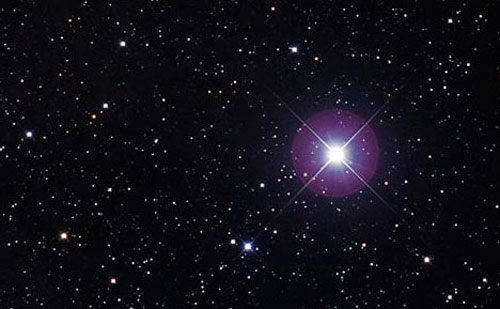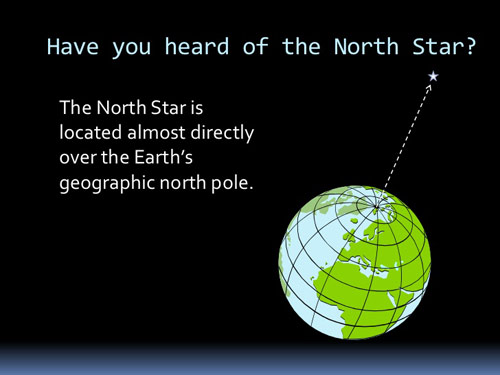Interesting things you didn't know about the 25,800 year old Northern star
The North Star (SBC) is not the brightest star, but its brightness is only average. In the ranking of the brightest stars, SBC did not even reach the top 40 but only ranked 48th.
What is the North Star?
SBC is the most important star because it is in the position where the earth's axis of rotation directly points to. Especially SBC will not grow or dive all night but almost always at a point above the northern horizon changes every year while other stars spin around it.
 (Photo: Modern Survival Blog).
(Photo: Modern Survival Blog).
So, you can always find SBC right in the North at the Northern hemisphere at any time of the night and any time of the year. And if you're in the North Pole, the Northern star will be right above you.
 The North Pole is always right on the north pole of the earth.(Photo: SlideShare).
The North Pole is always right on the north pole of the earth.(Photo: SlideShare).
Where is the North Pole and how does it determine?
Polaris belongs to the constellation Ursa Minor or Little Hung (Little Bear), sometimes called 'Stella Poris'.
According to Western astronomy, a notable star array in the Little Bear is 7 stars that form a spoon or ladle, Little Dipper (the Small Spoon), as opposed to Big Dipper (Big Spoon) array. The North Star in the Ursa Major or Dai Hung constellation is also nearby, brighter and easier to see. Little Dipper is rarely mentioned because its stars are so dim, that only a little moonlight or streetlight obscures its 4 dimmest stars.
In the sky, coinciding with Big and Little Dippers are always in opposite positions: when this array is vertical, the other array is upside down. The rolling part of these two sections also spreads in 2 opposite directions. And so far, when talking about them, people still see the Big Dipper long handle is brighter than the Little Dipper. (In different countries North Star or Big Dipper have different names: in the Netherlands is a pan, in England is a plow .)
The northern star is at the end of the handle (handle) of Little Dipper. The easiest way to find Polaris (North American star's short name) is based on two 'pointer' stars located on the mouth of Big Dipper: Dubhe and Merak. Very simply, you just need to draw a straight line between these two points, stretching 5 times in the direction from the bottom of the pot is going to see Polaris (see photo 3).
 The North Star is at the end of the rolling part of Little Dipper (lower left).The stars in the Little Dipper array are much dimmer than the Big Dipper (higher right).
The North Star is at the end of the rolling part of Little Dipper (lower left).The stars in the Little Dipper array are much dimmer than the Big Dipper (higher right).
What are the characteristics of the North Pole?
The present Arctic star is called Polaris , which is a variable star (Cepheid), meaning that it will light and dim according to a certain cycle. According to NASA's dictionary, Cepheid is a useful tool to help astronomers calculate cosmic distances from the earth to galaxies and star clusters. Cepheid's cycle correlates with the light of the celestial bodies it reflects and the farther away the celestial body is, the dimmer the light of Cepheid.
Located 434 light-years away, Polaris has a brightness of nearly 4000 times that of the sun and shines at level 2.
According to astronomers' apparent magnitude scale, the smaller the number, the brighter the object. The levels of the most brilliant stars and planets in the night sky are 0 or even negative numbers.
A Cepheid variable star, the variation in SBC's brightness is very small, only about one tenth of a level within less than 4 days (meaning that every 4 days you will see SBC brighter or a bit dimmer)
When using a small telescope to see SBC, you might notice a tiny companion companion (called Polaris Ab) that shines at level 9 with blue and gray shades. Polaris Ab is the first companion seen by the great British astronomer Sir William Herschel in 1780, just a year after he found Uranus.
According to astronomers, two stars A and Ab are about 2,400 astronomical units (au). Thus, the time for these two stars to turn around each other for many thousands of years. (1 au = average distance from the sun to the earth)
In the North Star system, another star, Polaris B, was discovered until 1929 by studying the spectrum of Polaris. Polaris B is a white dwarf that points to Polaris Ab 18,5 (the distance from Thien Vuong to the sun). Because it was too close to the star Polaris Ab many times brighter than it, Polaris B was unknown for a very long time.
 An artist's Arctic trio based on images of Hubble's telescope, Polaris super-dwarf, Polaris Ab dwarf and distant companion dwarf Polaris B (Photo: Greg Bacon / STScI).
An artist's Arctic trio based on images of Hubble's telescope, Polaris super-dwarf, Polaris Ab dwarf and distant companion dwarf Polaris B (Photo: Greg Bacon / STScI).
What is strange about the North Star?
Over the past few decades, the North Star has become brighter than before. Despite seeing with the naked eye, we still see the Arctic star quite fuzzy, but according to estimates by a group of scientists in 2014, the North Pole is now 4.6 times brighter than itself in ancient times. The reason for this phenomenon is still a big question mark.
In 2008, on the occasion of its 50th anniversary, NASA distributed The Beatles band "Across the Universe" to the Northern star from a broadcast station in Europe. It is also the anniversary of many important space events with the United States and the world such as 50 years of the first satellite launch of the US Explorer 1, 45 years to establish the Deep Space Network (where receiving signals from Unmanned space ships like Voyager).The"Across the Universe" is a 40-year-old birthdaydaysince the first recording!
 The DSS-63 broadcast station in a Spanish countryside, part of NASA's Deep Space Network, is used to broadcast "Across the Universe" to the North Star.(Photo: NASA).
The DSS-63 broadcast station in a Spanish countryside, part of NASA's Deep Space Network, is used to broadcast "Across the Universe" to the North Star.(Photo: NASA).
Forever only one Northern star?
The North Pole is not a constant as Shakespeare's famous quote leads to the Roman emperor Julius Caesar: 'I am as far away as the northern star'.
Indeed, at every moment the earth has only one star above the North Pole, but for centuries, the position of the North Pole will change so there will be many stars called Arctic stars in history.
According to Space.com, like the gravitational pull of the earth, the rotation of the earth depends on a force of torque caused by the total force of the moon and the sun. Therefore, the earth's axis also fluctuates slowly in a circle in the sky and the direction of this axis in space also changes slowly. This phenomenon is called progression, precession or precession in English. And so the position of the North Pole will also move slowly over the centuries.
 Model of dynamic / precession or precession phenomena of the gyroscope and earth axis.(Photo: brighthub).
Model of dynamic / precession or precession phenomena of the gyroscope and earth axis.(Photo: brighthub).
The current Arctic star will continue closer to the North Pole and reach the nearest position on 24/3/2100 with 27.15 minutes of supply or slightly smaller than the moon's diameter.
The cycle of accomplishing an oscillation of the earth axis is 25,800 years and different stars will turn into the North Star one after another at different times.
 The Arctic stars in history.(Photo: ScienceBlogs).
The Arctic stars in history.(Photo: ScienceBlogs).
In the past, the Arctic star of 2600 BC, the period of pyramid construction in ancient Egypt was the Thuban star in the constellation Draco. By 400 BC, the time of the famous Pluto philosopher, the brightest star Kochab became the North Star.
Going to the future, nearly 12,000 years from now, our ancestors will call Vega, one of the brightest stars in the sky as the North Star in 14,000.
- 10 interesting things about life you may not know
- Discover many interesting things in the star closest to the solar system
- Interesting New Year differences between Hanoi and Saigon
- 10 interesting things about nature you may not know
- 9 interesting things about stars
- Going from one surprise to the other is different from the interesting things about all things
- Super interesting things about math you will definitely fall back
- 10 most interesting things about Venus
- 12 horrible things about China you may not know
- Animal World - Interesting things you don't know
- 10 interesting things about cats
- 10 interesting things about the Internet that you don't know
 Van Allen's belt and evidence that the Apollo 11 mission to the Moon was myth
Van Allen's belt and evidence that the Apollo 11 mission to the Moon was myth The levels of civilization in the universe (Kardashev scale)
The levels of civilization in the universe (Kardashev scale) Today Mars, the sun and the Earth are aligned
Today Mars, the sun and the Earth are aligned The Amazon owner announced a secret plan to build a space base for thousands of people
The Amazon owner announced a secret plan to build a space base for thousands of people